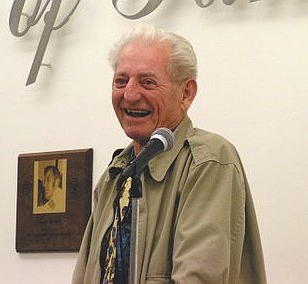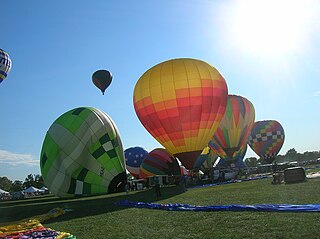
A hot air balloon is a lighter-than-air aircraft consisting of a bag, called an envelope, which contains heated air. Suspended beneath is a gondola or wicker basket, which carries passengers and a source of heat, in most cases an open flame caused by burning liquid propane. The heated air inside the envelope makes it buoyant, since it has a lower density than the colder air outside the envelope. As with all aircraft, hot air balloons cannot fly beyond the atmosphere. The envelope does not have to be sealed at the bottom, since the air inside the envelope is at about the same pressure as the surrounding air. In modern sport balloons the envelope is generally made from nylon fabric, and the inlet of the balloon is made from a fire-resistant material such as Nomex. Modern balloons have been made in many shapes, such as rocket ships and the shapes of various commercial products, though the traditional shape is used for most non-commercial and many commercial applications.

Jean Felix Piccard, also known as Jean Piccard, was a Swiss-born American chemist, engineer, professor and high-altitude balloonist. He invented clustered high-altitude balloons, and with his wife Jeannette, the plastic balloon. Piccard's inventions and co-inventions are used in balloon flight, aircraft and spacecraft.

The Gordon Bennett Cup is the world's oldest gas balloon race, and is "regarded as the premier event of world balloon racing" according to the Los Angeles Times. Referred to as the "Blue Ribbon" of aeronautics, the first race started from Paris, France, on September 30, 1906. The event was sponsored by James Gordon Bennett Jr., the millionaire sportsman and owner of the New York Herald newspaper. According to the organizers, the aim of the contest "is simple: to fly the furthest distance from the launch site." The contest ran from 1906 to 1938, interrupted from 1914 to 1919 by World War I and in 1931, but was suspended in 1939 when the hosts, Poland, were invaded at the start of World War II. The event was not resurrected until 1979, when American Tom Heinsheimer, an atmospheric physicist, gained permission from the holders to host the trophy. The competition was not officially reinstated by the Fédération Aéronautique Internationale (FAI) until 1983.

In aeronautics, a balloon is an unpowered aerostat, which remains aloft or floats due to its buoyancy. A balloon may be free, moving with the wind, or tethered to a fixed point. It is distinct from an airship, which is a powered aerostat that can propel itself through the air in a controlled manner.

The Albuquerque International Balloon Fiesta is a yearly hot air balloon festival that takes place in Albuquerque, New Mexico, during early October. The Balloon Fiesta is a nine-day event occurring in the first full week of October, and has over 500 hot air balloons each year, far from its beginnings of merely 13 balloons in 1972. The event is the largest balloon festival in the world, followed by the Grand Est Mondial Air in France, and the León International Balloon Festival in Mexico.

Benjamin L. "Ben" Abruzzo was an American balloonist and businessman who helped make Albuquerque, New Mexico, into an international ballooning center. He was part of the balloon crews that made the first Atlantic Ocean crossing by balloon in the Double Eagle II and the first Pacific Ocean crossing by balloon in the Double Eagle V.
The Bluegrass Balloon Festival, formerly called the Adam Matthews Balloon Festival, was the fifth largest hot air balloon festival in the United States, and the largest in the state of Kentucky. From 1999 to 2009, it was held annually in late September at Bowman Field in Louisville, Kentucky.

The Great Pershing Balloon Derby is a hot air balloon festival held each Labor Day weekend near Brookfield, Missouri. The three-day festival draws balloonists from the midwest and as far away as Florida and the Pacific Northwest. It is named in honor of General John J. Pershing, leader of the American Expeditionary Forces in World War I and a native of nearby Laclede, Missouri. The Great Pershing Balloon Derby (GPBD) has been recognized as the longest running continually sanctioned ballooning event in the U.S. by the Balloon Federation of America.

Paul Edward Yost was the American inventor of the modern hot air balloon and is referred to as the "Father of the Modern Day Hot-Air Balloon." He worked for a high-altitude research division of General Mills in the early 1950s until he left to establish Raven Industries in 1956, along with several colleagues from General Mills.

Donald Louis Piccard was a Swiss-born American balloon pioneer, promoter, innovator, designer, builder, and pilot.

Hot air ballooning is the recreational and competitive adventure sport of flying hot air balloons. Attractive aspects of ballooning include the exceptional quiet, the lack of a feeling of movement, and the bird's-eye view. Since the balloon moves with the direction of the winds, the passengers feel absolutely no wind, except for brief periods during the flight when the balloon climbs or descends into air currents of different direction or speed. Hot air ballooning has been recognized by Fédération Aéronautique Internationale (FAI) as the safest air sport in aviation, and fatalities in hot air balloon accidents are rare, according to statistics from the National Transportation Safety Board (NTSB).

Balloons and kites were the first inventions used in aerial warfare and their primary role was reconnaissance. Balloons provided a reliable and stable means of elevating an observer high over the battlefield to obtain a birds-eye view of troop positions and movements. An early instrument of aerial intelligence collection, they were also useful for creating accurate battlefield maps, an important ingredient for battlefield success. Incendiary balloons also have a long history. The incendiary balloons carry hot air or something that can catch fire to destroy enemy territory. They could also hold small bombs for combat. The history of military ballooning dates back to the late 18th century, when the Montgolfier brothers, Joseph-Michel and Jacques-Étienne, first demonstrated the potential of hot-air balloons for military use. The first recorded military use of balloons was during the French Revolutionary Wars, when the French military used balloons to gather intelligence on the movements of the enemy. Balloons were also used during the American Civil War, where they were used for reconnaissance and communication. Balloons had a decline after several incidents in the interwar period.

Sophie Blanchard, commonly referred to as Madame Blanchard, was a French aeronaut and the wife of ballooning pioneer Jean-Pierre Blanchard. Blanchard was the first woman to work as a professional balloonist, and after her husband's death she continued ballooning, making more than 60 ascents. Known throughout Europe for her ballooning exploits, Blanchard entertained Napoleon Bonaparte, who promoted her to the role of "Aeronaut of the Official Festivals", replacing André-Jacques Garnerin. On the restoration of the monarchy in 1814 she performed for Louis XVIII, who named her "Official Aeronaut of the Restoration".

The Saga International Balloon Fiesta is held at the beginning of November every year in Saga Prefecture, Japan. In 2014 it took place between October 30 and November 3.

The history of ballooning, both with hot air and gas, spans many centuries. It includes many firsts, including the first human flight, first flight across the English Channel, first flight in North America, and first aircraft related disaster.

The Great Forest Park Balloon Race is an annual hot air balloon festival held in Forest Park in St. Louis, Missouri. With more than 70 entrants and 130,000 spectators, it is the most well-attended single-day hot air balloon race in the United States.

The 811th Cadet Squadron was one of the few remaining School Enrichment Program (SEP) Cadet Squadrons in Civil Air Patrol. It acted as a regular squadron, yet had a partnership with an in school elective class that was offered to students at the middle school, who do not need to be members to participate. This was before the squadron was retired, in 2023, due to lack of participating members, and loss of reliable location. The squadron members were re-distributed into the 855th Albuquerque Aviation Academy Cadet Squadron, which started later that year.
The National Balloon Classic is an annual hot air balloon festival held at the Memorial Balloon Field in Indianola, Iowa. The classic is a nine-day event with nearly 100 hot air balloons.

The Balloon Federation of America (BFA) is a 501c3 non-profit group for the advancement of lighter-than-air aviation which includes hot air and gas balloons. Founded in 1960, located in Indianola, Iowa. The BFA partners with the National Balloon Museum to induct outstanding individuals into the United States Ballooning Hall of Fame. The Federation presents multiple awards including the Ed Yost Master Pilot Award and the National Crew Person Award. The BFA facilitates balloon events by providing advice and guidance on FAA compliance.

















